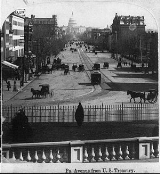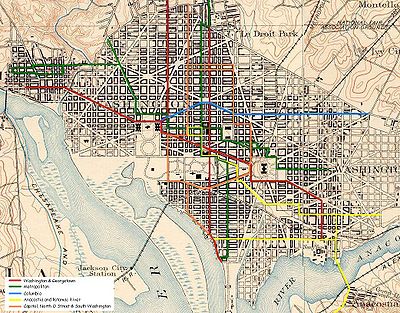
Washington and Georgetown Railroad
Encyclopedia

Georgetown, Washington, D.C.
Georgetown is a neighborhood located in northwest Washington, D.C., situated along the Potomac River. Founded in 1751, the port of Georgetown predated the establishment of the federal district and the City of Washington by 40 years...
to the Navy Yard
Washington Navy Yard
The Washington Navy Yard is the former shipyard and ordnance plant of the United States Navy in Southeast Washington, D.C. It is the oldest shore establishment of the U.S. Navy...
. Two additional lines ran on 7th Street NW/SW and 14th Street NW. In 1890 it switched from horse-drawn streetcars to cable cars. On September 21, 1895 the company was purchased by the Rock Creek Railway
Rock Creek Railway
The Rock Creek Railway was one of the first electric streetcar companies to operate in Washington, D.C. It was incorporated in 1888 and started operations in 1890. After expansion, the line ran from the Cardoza/Shaw neighborhood of D.C. to Chevy Chase Lake, Maryland...
and the two formed the Capital Traction Company
Capital Traction Company
The Capital Traction Company was the smaller of the two major street railway companies in Washington, D.C. in the early 20th Century. It was formed through a merger of the Rock Creek Railway and the Washington and Georgetown Railroad Company in 1895. The company ran streetcars from Georgetown;...
.
Origins
Prior to the development of side-bearing rail streetcar tracks in New York CityNew York City
New York is the most populous city in the United States and the center of the New York Metropolitan Area, one of the most populous metropolitan areas in the world. New York exerts a significant impact upon global commerce, finance, media, art, fashion, research, technology, education, and...
in 1852, transit in Washington D.C. consisted of horse-drawn wagons, or omnibuses, that ran on several established lines. As early as 1858 an effort was made by New York City businessmen to open a streetcar in Washington, D.C., but, it was not until May 17, 1862 that the first streetcar company, the Washington and Georgetown Railroad Company was incorporated. It was authorized to build three street horsecar
Horsecar
A horsecar or horse-drawn tram is an animal-powered streetcar or tram.These early forms of public transport developed out of industrial haulage routes that had long been in existence, and from the omnibus routes that first ran on public streets in the 1820s, using the newly improved iron or steel...
lines using the standard
Standard gauge
The standard gauge is a widely-used track gauge . Approximately 60% of the world's existing railway lines are built to this gauge...
track gauge of the Baltimore and Ohio Railroad
Baltimore and Ohio Railroad
The Baltimore and Ohio Railroad was one of the oldest railroads in the United States and the first common carrier railroad. It came into being mostly because the city of Baltimore wanted to compete with the newly constructed Erie Canal and another canal being proposed by Pennsylvania, which...
.
The first streetcar started running on Pennsylvania Avenue NW from the Capitol to the State Department on July 29, 1862. Full operations, from the Navy Yard
Washington Navy Yard
The Washington Navy Yard is the former shipyard and ordnance plant of the United States Navy in Southeast Washington, D.C. It is the oldest shore establishment of the U.S. Navy...
to Georgetown
Georgetown, Washington, D.C.
Georgetown is a neighborhood located in northwest Washington, D.C., situated along the Potomac River. Founded in 1751, the port of Georgetown predated the establishment of the federal district and the City of Washington by 40 years...
on Pennsylvania Avenue NW/SE, began on October 2, 1862. It ran from the intersection of High Street and Bridge Street (Now Wisconsin Ave NW and M St NW) in Georgetown along Bridge Street to Pennsylvania Avenue. Then along Pennsylvania Avenue, past the White House to the foot of the Capitol Building. From there it went north on 1st St NW one block, then east on B St NW/NE for two blocks, then south across the Capitol Grounds on the east side of the Capitol and back onto Pennsylvania Avenue. It traveled southeast on Pennsylvania to 8th St SE where it turned south to the Navy Yard stopping at M St SE and 8th St SE.
Expansion
A second line opened on November 15, 1862. It was built along 7th Street NW from N Street NW to the Potomac RiverPotomac River
The Potomac River flows into the Chesapeake Bay, located along the mid-Atlantic coast of the United States. The river is approximately long, with a drainage area of about 14,700 square miles...
. In 1863 the 7th Street line was extended north to Boundary Street NW. It expanded south to the Arsenal (now Fort McNair) in 1875.
A third line, built by 1870, ran down 14th Street NW from Boundary Street NW (now Florida Avenue
Florida Avenue (Washington, D.C.)
Florida Avenue is a major street in Washington, D.C. It was originally named Boundary Street, because it formed the northern boundary of Pierre L'Enfant's original plan for the Federal City...
) to the Treasury Building.
In 1877, the company built a car barn at 13th and Boundary Streets NW. From 1877-92, the company expanded the facility several times, adding a blacksmith
Blacksmith
A blacksmith is a person who creates objects from wrought iron or steel by forging the metal; that is, by using tools to hammer, bend, and cut...
shop in 1878.
The omnibus company that existed prior to the introduction of streetcars was run out of business. Its Georgetown stable
Stable
A stable is a building in which livestock, especially horses, are kept. It most commonly means a building that is divided into separate stalls for individual animals...
s were eventually purchased by the Washington and Georgetown line to be used as a car barn and, much later, as machine shops.
Switch to Cable Cars

Horse
The horse is one of two extant subspecies of Equus ferus, or the wild horse. It is a single-hooved mammal belonging to the taxonomic family Equidae. The horse has evolved over the past 45 to 55 million years from a small multi-toed creature into the large, single-toed animal of today...
power to underground cable
Cable car (railway)
A cable car or cable railway is a mass transit system using rail cars that are hauled by a continuously moving cable running at a constant speed. Individual cars stop and start by releasing and gripping this cable as required...
or to electricity
Electricity
Electricity is a general term encompassing a variety of phenomena resulting from the presence and flow of electric charge. These include many easily recognizable phenomena, such as lightning, static electricity, and the flow of electrical current in an electrical wire...
provided by battery
Battery (electricity)
An electrical battery is one or more electrochemical cells that convert stored chemical energy into electrical energy. Since the invention of the first battery in 1800 by Alessandro Volta and especially since the technically improved Daniell cell in 1836, batteries have become a common power...
or underground wire
Wire
A wire is a single, usually cylindrical, flexible strand or rod of metal. Wires are used to bear mechanical loads and to carry electricity and telecommunications signals. Wire is commonly formed by drawing the metal through a hole in a die or draw plate. Standard sizes are determined by various...
and in 1890 companies were authorized to sell stock
Stock
The capital stock of a business entity represents the original capital paid into or invested in the business by its founders. It serves as a security for the creditors of a business since it cannot be withdrawn to the detriment of the creditors...
to pay for the upgrades - provided they did not involve overhead wires. In 1892, one-horse cars were banned within the city, and by 1894 Congress began requiring companies to switch to something other than horse power while continuing to disallow overhead lines within the city.
Immediately after the 1889 law was passed, the Washington and Georgetown began installing an underground cable system. Their 7th Street line was switched to a cable car system on April 12, 1890. Sixteen cars traveled on the route at 6 mph at three minute intervals, from 5:00 AM
12-hour clock
The 12-hour clock is a time conversion convention in which the 24 hours of the day are divided into two periods called ante meridiem and post meridiem...
to 1:00 AM daily. The rest of the system was in operation by August 18, 1892. Two cables pulled the cars up and down Pennsylvania Avenue NW/SE between the Navy Yard and Georgetown. The company built five new facilities to handle the cable car operations. In 1892, they extended their track along 14th to Mount Pleasant Street NW (now Park Road NW) and built a new barn there. They moved the cars from the barn at 13th Street and Florida Avenue NW to the new one and sold the older facility which was converted into a printing
Printing
Printing is a process for reproducing text and image, typically with ink on paper using a printing press. It is often carried out as a large-scale industrial process, and is an essential part of publishing and transaction printing....
plant. In 1893, the company built the Navy Yard Car Barn across from the Navy Yard to service the new cars.
The company built two powerhouses
Power station
A power station is an industrial facility for the generation of electric energy....
to provide energy for the system, one at 14th Street NW and E Street NW and the other at 7th Street SW and P Street SW. In the middle of the intersection of 14th Street NW and Pennsylvania Avenue NW a large wheel pit was constructed. In addition the company was authorized, on August 23, 1894, to extend its line on M Street NW to the Aqueduct Bridge, and build a "Union Station" - now the Georgetown Car Barn.
The End of the Line
By the mid-1890s there were numerous streetcar companies operating in the District. Congress tried to deal with this fractured transit system by requiring them to accept transfersTransfer (public transit)
A transfer allows the rider of a public transportation vehicle who pays for a single-trip fare to continue the trip on another bus or train. Depending on the network, there may or may not be an additional fee for the transfer...
, set standard pricing
Pricing
Pricing is the process of determining what a company will receive in exchange for its products. Pricing factors are manufacturing cost, market place, competition, market condition, and quality of product. Pricing is also a key variable in microeconomic price allocation theory. Pricing is a...
and by allowing them to use one another's track. But eventually it became clear that consolidation
Consolidation (business)
Consolidation or amalgamation is the act of merging many things into one. In business, it often refers to the mergers and acquisitions of many smaller companies into much larger ones. In the context of financial accounting, consolidation refers to the aggregation of financial statements of a group...
was the best solution.
On March 1, 1895, Congress authorized the Rock Creek Railway
Rock Creek Railway
The Rock Creek Railway was one of the first electric streetcar companies to operate in Washington, D.C. It was incorporated in 1888 and started operations in 1890. After expansion, the line ran from the Cardoza/Shaw neighborhood of D.C. to Chevy Chase Lake, Maryland...
to purchase the Washington and Georgetown. It did so on September 21, 1895 forming the Capital Traction Company
Capital Traction Company
The Capital Traction Company was the smaller of the two major street railway companies in Washington, D.C. in the early 20th Century. It was formed through a merger of the Rock Creek Railway and the Washington and Georgetown Railroad Company in 1895. The company ran streetcars from Georgetown;...
, the first company created during "the great streetcar consolidation" and spelling the end of the Washington and Georgetown Railroad Company as a unique entity.

